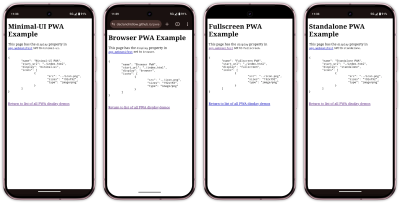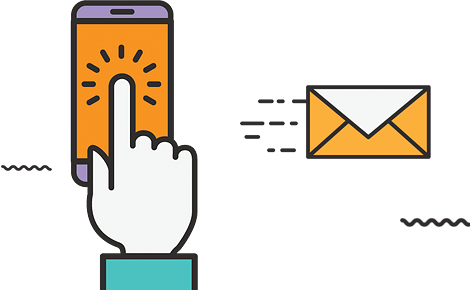- 10 min learn
- Apps,
PWA,
Optimization,
Ways
Innovative web apps (PWA) are an wonderful technique to flip web applications into native-admire, standalone experiences. They bridge the outlet between web sites and native apps, but this transformation will also be inclined to introducing abolish challenges that require thoughtful consideration.
We clarify our PWAs with a manifest file. In our PWA’s manifest, we can pick from a series of point out modes, every offering varied stages of browser interface visibility:
fullscreen: Hides all browser UI, the use of the whole point out.standalone: Looks to be like admire a native app, hiding browser controls but conserving system UI.minimal-ui: Shows minimal browser UI parts.browser: Fashioned web browser skills with fat browser interface.
Oftentimes, we desire our PWAs to if truth be told feel admire apps somewhat than a web web website in a browser, so we dwelling the point out manifest member to some of the options that hides the browser’s interface, equivalent to fullscreen or standalone. That is candy for helping originate our applications if truth be told feel more at house, but it’ll introduce some components we wouldn’t in total beget in thoughts when building for the online.
It’s easy to neglect correct how a lot functionality the browser affords to us. Issues admire forward/help buttons, the flexibility to refresh a website, search internal pages, or even manipulate, portion, or replica a website’s URL are all browser-offered parts that users can lose obtain admission to to when the browser’s UI is hidden. There’ll seemingly be the case of things that we point out on web sites that don’t necessarily translate to app experiences.

Imagine a user deep into a invent and not utilizing a help button, attempting to portion a product website without the flexibility to replica a URL, or hitting a worm and not utilizing a refresh button to bail them out!
Fortunately, we’re offered with loads of how to customize the online.
We use media queries the whole time when writing CSS. Whether or no longer it’s switching up styles for print or surroundings breakpoints for responsive abolish, they’re no longer unusual within the online developer’s toolkit. Each of the point out modes discussed previously will also be aged as a media inquire to change the look of paperwork relying.
Media queries equivalent to @media (min-width: 1000px) are inclined to obtain essentially the most use for surroundings breakpoints consistent with the viewport size, but they’re able to up to now more. They may be able to address print styles, application orientation, contrast preferences, and a whole ton more. In our case, we’re attracted to the display-mode media aim.
Expose mode media queries correspond to essentially the latest point out mode.
Show: Whereas we could dwelling point out modes in our manifest, the exact point out mode could differ looking out on browser enhance.
These media queries straight away reference essentially the latest mode:
@media (display-mode: standalone)will handiest apply to pages dwelling to standalone mode.@media (display-mode: fullscreen)applies to fullscreen mode. It’s far price noting that this also applies when the use of the Fullscreen API.@media (display-mode: minimal-ui)applies to minimal UI mode.@media (display-mode: browser)applies to customary browser mode.
It’s also price conserving an stare out for the window-controls-overlay and tabbed point out modes. On the time of writing, these two point out modes are experimental and could be aged with display_override. display-override is a member of our PWA’s manifest, admire display, but affords some extra options and energy.
display has a predetermined fallback chain (fullscreen -> standalone -> minimal-ui -> browser) that we can’t exchange, but display-override permits surroundings a fallback state of our picking, admire the following:
"display_override": ["fullscreen", "minimal-ui"]
window-controls-overlay can handiest apply to PWAs operating on a desktop working system. It makes the PWA take within the whole window, with window regulate buttons exhibiting as an overlay. Meanwhile, tabbed is said when there are more than one applications internal a single window.
To boot to to these, there’ll seemingly be the picture-in-picture point out mode that applies to (you guessed it) portray-in-portray modes.
We use these media queries exactly as we would every other media inquire. To gift an element with the class .pwa-only when the point out mode is standalone, we could carry out this:
.pwa-only {
display: none;
}
@media (display-mode: standalone) {
.pwa-only {
display: block;
}
}
If we wished to gift the element when the point out mode is standalone or minimal-ui, we could carry out this:
@media (display-mode: standalone), (display-mode: minimal-ui) {
.pwa-only {
display: block;
}
}
As great as it is miles, most frequently CSS isn’t enough. In these conditions, we could reference the point out mode and originate wanted adjustments with JavaScript:
const isStandalone = window.matchMedia("(display-mode: standalone)").matches;
// Listen for display mode changes
window.matchMedia("(display-mode: standalone)").addEventListener("change", (e) => {
if (e.matches) {
// App is now in standalone mode
console.log("Running as PWA");
}
});
Ultimate Applications
Now that we know options to originate point out modifications looking out on whether or no longer users are the use of our web app as a PWA or in a browser, we can beget a gape at how we could set apart these newly learnt talents to use.
Tailoring Narrate material For PWA Users
Users who beget an app installed as a PWA are already converted, so that you just may perhaps tweak your app to tone down the selling talk and focal point on the user skills. Since these users beget demonstrated dedication by installing your app, they seemingly don’t need promotional state or installation prompts.
Expose More Choices And Parts
You will beget to straight away articulate more things in PWA mode, as folk gained’t be ready to obtain admission to the browser’s settings as without anguish when the browser UI is hidden. Parts admire altering font sizing, switching between gentle and sad mode, bookmarks, sharing, tabs, etc., could need an in-app different.
Platform-Appropriate Parts
There are parts you gained’t desire for your web app due to they actually feel out of self-discipline, but that you just seemingly can desire for your PWA. A factual example is the underside navigation bar, which is total in native cellular apps as a result of less complicated reachability it affords, but extraordinary on web sites.
Of us most frequently print web sites, but they very most frequently ever print apps. Rep in mind whether or no longer parts admire print buttons needs to be hidden in PWA mode.
Install Prompts
A total annoyance is a suggested to set up a dwelling as a PWA exhibiting when the user has already installed the dwelling. Ideally, the browser will present an set up suggested of its hang if our PWA is configured precisely, but no longer all browsers carry out, and it’ll even be finicky. MDN has an wonderful manual on establishing a personalised button to trigger the installation of a PWA, but it gained’t match our wants.
We can toughen things by hiding set up prompts with our media inquire or detecting essentially the latest point out mode with JavaScript and forgoing triggering popups within the first self-discipline.
We could even dwelling this up as a reusable utility class so as that the leisure we don’t are seeking to be displayed when the app is installed as a PWA will also be hidden with ease.
/* Utility class to hide elements in PWA mode */
.hide-in-pwa {
display: block;
}
@media (display-mode: standalone), (display-mode: minimal-ui) {
.hide-in-pwa {
display: none !important;
}
}
Then for your HTML:
We could carry out the different and accomplish a utility class to originate parts handiest gift when in a PWA, as we discussed earlier.
Strategic Use Of Scope And Originate URL
Some other technique to shroud state out of your dwelling is to dwelling the scope and start_url properties. These aren’t the use of media queries as we’ve discussed, but needs to be regarded as as ways to gift varied state looking out on whether or no longer a dwelling is installed as a PWA.
Here is an example of a manifest the use of these properties:
{ "name": "Example PWA","scope": "/dashboard/","start_url": "/dashboard/index.html","display": "standalone", "icons": [ { "src": "icon.png", "sizes": "192x192", "type": "image/png" } ] }
scope right here defines the tip level of the PWA. When users stir away the scope of your PWA, they’ll peaceful beget an app-admire interface but build obtain admission to to browser UI parts. This could be helpful if you’ve got certain parts of your app that you just continue to are seeking to be half of the PWA but which aren’t necessarily optimised or making the significant concerns.
start_url defines the URL a user shall be offered with when they start the application. That is useful if, to illustrate, your app has marketing state at example.com and a dashboard at example.com/dashboard/index.html. It’s far seemingly that folk which beget installed the app as a PWA don’t need the selling state, so that you just may perhaps dwelling the start_url to /dashboard/index.html so the app begins on that website when they start the PWA.
Enhanced Transitions
Peep transitions can if truth be told feel extraordinary, out of self-discipline, and a tad gaudy on the online, but are a total aim of native applications. We can dwelling up PWA-handiest seek for transitions by wrapping the connected CSS precisely:
@media (display-mode: standalone) {
@view-transition {
navigation: auto;
}
}
Ought to you’re if truth be told mettlesome, you seemingly can tweak the abolish of a dwelling fully to suit more carefully with native abolish systems when operating as a PWA by pairing a check for the point out mode with a check for the application and/or browser in use as wished.
Browser Toughen And Making an try out
Browser enhance for point out mode media queries is factual and wide. On the opposite hand, it’s price noting that Firefox doesn’t beget PWA enhance, and Firefox for Android handiest shows PWAs in browser mode, so you seemingly can peaceful originate the significant concerns. Fortunately, revolutionary enhancement is on our side. If we’re going by a browser lacking enhance for PWAs or these media queries, we’ll be treated to stunning degradation.
Making an try out PWAs will also be provocative due to every application and browser handles them in a different way. Each point out mode behaves a miniature in a different way in every browser and OS aggregate.
Unfortunately, I don’t beget a silver bullet to give you with regard to this. Browsers don’t beget a helpful technique to simulate point out modes for testing, so you’ll beget to check out your PWA on varied devices, browsers, and dealing systems to originate sure all the pieces works everywhere it could peaceful, as it could peaceful.
Recap
Utilizing a PWA is a essentially varied skills from the use of a web-based app within the browser, so concerns needs to be made. display-mode media queries present a essential technique to carry out if truth be told adaptive Innovative Web Apps that respond intelligently to their installation and point out context. By leveraging these queries, we can carry out the following:
- Veil redundant installation prompts for users who beget already installed the app,
- Provide applicable navigation aids when making browser controls unavailable,
- Tailor state and functionality to match user expectations in varied contexts,
- Set up more native-feeling experiences that respect platform conventions, and
- Step by step give a enhance to the skills for dedicated users.
As PWAs continue to feeble, thoughtful implementations and tailoring will change into increasingly crucial for establishing if truth be told compelling app experiences on the online. Ought to you’re itching for even more data and PWA pointers and options, beget a beget a study Ankita Masand’s “Broad Recordsdata To Innovative Web Applications”.
Extra Discovering out On 4ndsMag
- “Creating A Magento PWA: Customizing Issues vs. Coding From Scratch”, Alex Husar
- “How To Optimize Innovative Web Apps: Going Beyond The Fundamentals”, Gert Svaiko
- “How To Decide Which PWA Parts Ought to Stick”, Suzanne Scacca
- “Uniting Web And Native Apps With 4 Unknown JavaScript APIs”, Juan Diego Rodríguez
(gg, yk)






